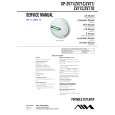|
|
|
Productos
|
|
Información
|
|
Destacado
|
|
|
 |
|
|
No hay comentarios de productos.
5.1 CHANNEL SURROUND SET-UP Begin set-up by placing the Left and Right front channels 30º degrees from the Center channel and equidistant to the listening position (Figure 4). The Left Surround (Rear) and Right Surround (Rear) channels should be placed 110º degrees from the Center channel. Their location should also be equidistant from the listening position. The subwoofer (Low Frequency Effects) channel is most effective when situated directly below the Center channel (as shown in Figure 4). If this is not possible place the subwoofer just to the right or left side and below the Center channel. Make sure that the woofers are above the height of the
Troubleshooting
Problem: If there is no power, check to see if... � The power cord is plugged into both the IEC socket on the rear panel of the unit and into the AC mains � The AC mains voltage is matched to the operating voltage requirements (See Changing Voltage in the Connecting the System section on page 3). If the AC mains voltage is higher than the V-8�s selected voltage it is possible that the fuse needs to be replaced. (See Changing Fuses in the Connecting the System section on page 3). � The power light is illuminated on the front panel of the V8. If not, turn the power switch OFF and check the A/C mains fuse(s). NEVER USE A LARGER AMPER AGE FUSE THAN IS SPECIFIED! Turn the power switch back on. The power light should illuminate. � If a fuse change was needed and upon powering the monitor back up the fuse(s) blow again, the monitor needs to be returned to the dealer you purchased it from or to KRK for servicing. Problem: If you can't hear any sound... � Repeat steps in the previous troubleshooting section above before continuing to the next steps. � Check to see if all other audio devices using the same AC outlet are still operat ing. � Make sure that: � The audio source cable is plugged into both the source output and the monitor input. � The System Gain pot is turned up fully clockwise (+ 6 dB). � The signal source (E.g. mixing console, work station, CD player, etc.) is turned up to a level that can properly send a signal to the monitors. � If one of the monitors is working. Exchange the audio input cable from the nonworking monitor to the working unit. This will determine whether it's really the monitor, a faulty cable, or some other glitch in the audio chain. � If the monitor is still not responding, it should be returned to the dealer that you purchased it from or to KRK for servicing. Problem: If the monitor suddenly stops working... � Turn the monitor send down or off. � Repeat steps in the troubleshooting sections above before continuing to the next steps. � Carefully check to see if the amplifier's back plate is hot! If the monitor has been running at highest power output for an extended period of time, it could be that the unit has become overheated and the protection circuitry has shut the system down momentarily. The V8 provides maximum circuitry protection against AC power surges, amplifier overdrive, and overheating of the amplifiers. Turn the monitor off then wait 30 minutes to allow the back plate to cool down. Turn the power switch back on. � Increase the volume to check for normal operation. � If the monitor is still not responding, it should be returned to the dealer that you purchased it from or to KRK for servicing.
Figure 4 console.Once the monitors have been placed, you need to adjust the SYSTEM GAIN pots (see page 2) for each monitor so that all channels have exactly the same SPL output at the listening position. Although this can be done simply by listening to each channel one at a time and adjusting for relative levels, we recommend using an SPL meter and filtered noise (pink noise) to test each channel independently. Simply take a reading from each monitor, and then adjust all the monitors to match your lowest SPL reading. Your system levels should now be balanced for multi-channel surround. The most significant thing to remember is that each room presents its own set of acoustic variables. You'll want to experiment a bit to arrive at the best possible sound for your room.
8
9
|
|
 |
> |
|

